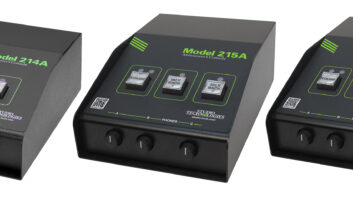QUINCY, Ill. In July 2009, Harris evaluated a new product available to the market from Phase Technologies, the Phase Perfect Digital Phase Converter.
Many manufacturers’ power supply designs, modern and legacy, incorporate a linear type power supply. Linear type supplies consist of a contactor(s), transformer, rectifiers and filter components such as capacitors and inductors. While this design is robust and exhibits benefits such as high-current or voltage capability, high efficiency and high-load isolation to line transients, a downside is they often have fixed single-phase or three-phase input power configuration.
Dilemma

This often creates a dilemma when a broadcaster acquires a three-phase transmitter and only single-phase power is available at a site.
Many times, the option of converting the site to three-phase electrical service is not financially practical if the broadcast facility is a considerable distance from three-phase service. Seeking a solution, Harris contacted Phase Technologies to request a Phase Perfect model PT355 phase converter for evaluation.
A Phase Perfect converts single-phase to three-phase power in a “high leg” delta configuration specifically for such three-phase power equipment applications. Two legs pass directly through, while a third leg is internally generated. According to the performance specifications, the generated leg has very low distortion and voltage balance within 1 percent. Overall efficiency of the converter is 97 percent, better than the rotary design.
Steve Mathiesen at Phase Perfect addressed any potential skepticism by explaining that the units are UL tested and certified and rugged enough for broadcast applications. Designs similar to the PT355 have undergone extensive testing by a military contractor that uses power conditioners for field operations in Iraq and Afghanistan.
With a rated output of 55 A, the PT355 was deemed appropriate for the 10 kW FM application after review of the demand requirements and a quick consultation with the manufacturer. Since the generated leg is a “high leg,” all 120 VAC loads, such as building lights, must be derived from the original two single-phase to neutral feeds, while the third leg to neutral is not used.
Our evaluation only included operation on the original shipping pallet. The unit was delivered with dimensions of 26 inches high x 19 inches wide x 14 inches deep and weighed just over 110 pounds. With only a two-inch side and six-inch top and bottom spacing requirement for cooling, the wall-mount unit can be considered small, relatively lightweight and easy to install.
One immediate noticeable difference was its quietness. The noise level of the electronic version is an improvement to the traditional rotary phase converter; the unit produced only a faint buzzing sound even at a 120 percent load.
A second appreciable difference is that the unit provides an instantaneous balanced three-phase output AC voltage once provided an AC input within the normal input operating range of 187–260 volts. The restart time of about 12 seconds was simply cumulative with the restart time of the transmitter we tested. While any delay is undesirable, even a small interruption in power causes a longer total restart time. This is an important advantage because it simplifies the integration of the phase converter and transmitter as a system.
Delay
Specifically, the instantaneous application of balanced three-phase voltage removes the requirement in some applications to add a time-delay circuit to delay the transmitter from coming back on after an AC outage until the rotary version is fully “at speed.” Without the delay, applying a full load while the rotary version is not at full-voltage output develops excessive current that may subsequently open a fuse or trip a circuit breaker, requiring a visit to restore service.
We connected the single-phase input through a variable power transformer and adjusted the AC input throughout the rated operating range. During each scenario of exceeding high- and low-AC line, as well as single and multiple short and long power interruptions, the transmitter seamlessly completed an AC restart sequence.
Fusing on the single-phase input and three-phase output is a requirement. While the Phase Perfect has over-current protection to shut down the output should it exceed the maximum current rating, output fusing is still recommended for safety. This added disconnect ensures power is completely removed and proper lockout/tagout procedures can be put in place prior to servicing. This also provides ease of maintenance when the disconnect is placed near the transmitter.
Harris has deployed three units for broadcast applications. Two are operating with Harris transmitters, one of them for radio in the United States and one for TV in the Philippines. The radio user is Joe Puma at WNED(FM), a Class B 6 kW station operating a Harris Z12HD+ HD Radio transmitter. Joe has reported similar experiences with no surprises, quick installation, clean output voltage and excellent regulation, and can’t imagine a better service from his utility provider. Joe states he did witness an AC outage, and the return to air time was acceptable.
Harris is now evaluating higher-power models on varying loads such as those common with AM broadcasts. Phase Perfect models are available with rated output up to 160 A.
Terry Cockerill is a radio product line manager with Harris Broadcast Communications.
For information, contact Phase Technologies in South Dakota at (605) 343-7934 or visitwww.phasetechnologies.com.












